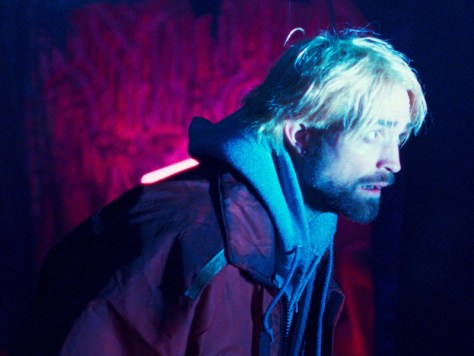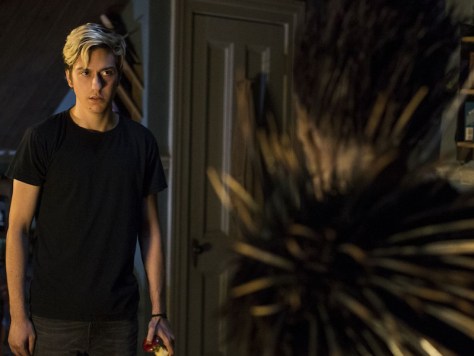
Best Picture
- Call Me By Your Name
- Darkest Hour
- Dunkirk
- Get Out
- Lady Bird
- Phantom Thread
- The Post
- The Shape of Water
- Three Billboards Outside Ebbing, Missouri
More than most years, this group of Best Picture nominees is particularly stellar. Each of my top 3 films from last year are present, along with a few others from my top 20, and even the ones that didn’t quite work for me are respectable achievements in their own right. It seems to be a two pony race between Shape and Billboards (Shape currently holds favor, thus my prediction) but I wouldn’t be surprised to see any of the other 7 make a February push, especially after the shenanigans from last year’s Best Picture race.
My Prediction: The Shape of Water
My Vote: Three Billboards Outside Ebbing, Missouri
Overlooked: The Big Sick
Best Director
- Paul Thomas Anderson – Phantom Thread
- Guillermo del Toro – The Shape of Water
- Greta Gerwig – Lady Bird
- Christopher Nolan – Dunkirk
- Jordan Peele – Get Out
Again, another excellent field marked with very deserved nominees. Gerwig is only the fifth woman to be nominated in the field, while Peele is only the fifth black nominee ever for the category, even more impressive when you factor in that both of their films were directorial debuts. This award is more firmly predicted for del Toro at this point, with Nolan being a dark horse for his determined work on Dunkirk.
My Prediction: Guillermo del Toro
My Vote: Paul Thomas Anderson
Overlooked: Martin McDonagh – Three Billboards Outside Ebbing, Missouri
Best Actor
- Timothée Chalamet – Call Me By Your Name
- Daniel Day-Lewis – Phantom Thread
- Daniel Kaluuya – Get Out
- Gary Oldman – Darkest Hour
- Denzel Washington – Roman J. Israel, Esq
Darkest Hour remains one of my few Oscar blindspots from last year and while I’m sure Oldman does a terrific job in it as he almost always does, the role whiffs strongly of Oscar bait (especially in a year with so little of it) and I wish some of these other actors had a chance. Unfortunately, they don’t; this is one of the surest picks of the evening.
My Prediction: Gary Oldman
My Vote: Daniel Kaluuya
Overlooked: Robert Pattinson – Good Time
Best Actress
- Sally Hawkins – The Shape of Water
- Frances McDormand – Three Billboards Outside Ebbing, Missouri
- Margot Robbie – I, Tonya
- Saoirse Ronan – Lady Bird
- Meryl Streep – The Post
Like Oldman for Actor, McDormand is all over this category but given how big a fan I am with her performance in Billboards (I can’t imagine what the film would have been without it), I’m excited for her to walk home with Oscar gold for the second time. Newcomer Meryl Streep nabs her very 1st nomination in…ah, sorry. Read that wrong. It’s 21st. Meryl Streep has been nominated for an Oscar 21 times.
My Prediction: Frances McDormand
My Vote: Frances McDormand
Overlooked: Jennifer Lawrence – mother!
Best Supporting Actor
- Willem Dafoe – The Florida Project
- Woody Harrelson – Three Billboards Outside Ebbing, Missouri
- Richard Jenkins – The Shape of Water
- Christopher Plummer – All the Money in the World
- Sam Rockwell – Three Billboards Outside Ebbing, Missouri
My Prediction: Sam Rockwell
My Vote: Willem Dafoe
Overlooked: Ray Romano – The Big Sick
Best Supporting Actress
- Mary J. Blige – Mudbound
- Allison Janney – I, Tonya
- Lesley Manville – Phantom Thread
- Laurie Metcalf– Lady Bird
- Octavia Spencer – The Shape of Water
My Prediction: Allison Janney
My Vote: Lesley Manville
Overlooked: Holly Hunter – The Big Sick
It’s Rockwell and Janney in front, with Dafoe and Metcalf trailing distantly behind them. Odd that things have shaken out this way, as Dafoe and Metcalf have been scooping up other awards left and right for their performances but as the Oscars loom large, two other frontrunners emerge. Plenty of great nods here, especially the stunt pick of Christopher Plummer in a performance captured entirely during reshoots approximately a month or two before the film was released.
Best Original Screenplay
- The Big Sick – Emily V. Gordon & Kumail Nanjiani
- Get Out – Jordan Peele
- Lady Bird – Greta Gerwig
- The Shape of Water – Guillermo del Toro & Vanessa Taylor
- Three Billboards Outside Ebbing, Missouri – Martin McDonagh
My Prediction: Lady Bird
My Vote: Get Out
Overlooked: Logan Lucky
Best Adapted Screenplay
- Call Me By Your Name – James Ivory from Call Me By Your Name by André Aciman
- The Disaster Artist – Scott Neustadter & Michael H. Weber from The Disaster Artist: My Life Inside The Room, the Greatest Bad Movie Ever Made by Greg Sestero & Tom Bissell
- Logan – Scott Frank, James Mangold & Michael Green from Wolverine by Roy Thomas, Len Wein & John Romita Sr.
- Molly’s Game – Aaron Sorkin from Molly’s Game: From Hollywood’s Elite to Wall Street’s Billionaire Boys Club, My High-Stakes Adventure in the World of Underground Poker by Molly Bloom
- Mudbound – Dee Rees & Virgil Williams from Mudbound by Hillary Jordan
My Prediction: Call Me By Your Name
My Vote: Logan
Overlooked: Their Finest
Best Animated Feature Film
- Boss Baby
- The Breadwinner
- Coco
- Ferdinand
- Loving Vincent
My Prediction: Coco
My Vote: —
Overlooked: The Lego Batman Movie
Best Foreign Language Film
- A Fantastic Woman
- The Insult
- Loveless
- On Body and Soul
- The Square
My Prediction: A Fantastic Woman
My Vote: The Square
Overlooked: Raw
Best Documentary – Feature
- Abacus: Small Enough to Jail
- Faces Places
- Icarus
- Last Men in Aleppo
- Strong Island
My Prediction: Faces Places
My Vote: —
Overlooked: The Work
Best Documentary – Short Subject
- Edith & Eddie
- Heaven is a Traffic Jam
- Heroin(e)
- Knifeskills
- Traffic Stop
My Prediction: Edith & Eddie
My Vote: —
Overlooked: —
Best Live Action Short Film
- DeKalb Elementary
- The Eleven O’Clock
- My Nephew Emmet
- Silent Child
- Watu Wote:All of Us
My Prediction: DeKalb Elementary
My Vote: —
Overlooked: —
Best Animated Short Film
- Dear Basketball
- Garden Party
- Lou
- Negative Space
- Revolting Rhymes
My Prediction: Dear Basketball
My Vote: —
Overlooked: —
Best Original Score
- Dunkirk – Hans Zimmer
- Phantom Thread – Jonny Greenwood
- The Shape of Water – Alexandre Desplat
- Star Wars: The Last Jedi – John Williams
- Three Billboards Outside Ebbing, Missouri – Carter Burwell
My Prediction: The Shape of Water
My Vote: Phantom Thread
Overlooked: Good Time – Oneohtrix Point Never
Best Original Song
- “Mighty River” from Mudbound
- “Mystery of Love” from Call Me By Your Name
- “Remember Me” from Coco
- “Stand Up for Something” from Marshall
- “This is Me” from The Greatest Showman
My Prediction: “Remember Me”
My Vote: “Mystery of Love”
Overlooked: “The Pure And The Damned” from Good Time
Best Sound Editing
- Baby Driver
- Blade Runner 2049
- Dunkirk
- The Shape of Water
- Star Wars: The Last Jedi
My Prediction: Dunkirk
My Vote: Baby Driver
Overlooked: Guardians of the Galaxy Vol. 2
Best Sound Mixing
- Baby Driver
- Blade Runner 2049
- Dunkirk
- The Shape of Water
- Star Wars: The Last Jedi
My Prediction: Dunkirk
My Vote: Baby Driver
Overlooked: John Wick: Chapter 2
Best Production Design
My Prediction: The Shape of Water
My Vote: Blade Runner 2049
Overlooked: It Comes At Night
Best Cinematography
- Blade Runner 2049– Roger Deakins
- Darkest Hour – Bruno Delbonnel
- Dunkirk – Hoyte van Hoytema
- Mudbound – Rachel Morrison
- The Shape of Water – Dan Laustsen
My Prediction: Blade Runner 2049
My Vote: Blade Runner 2049
Overlooked: The Killing of a Sacred Deer – Thimios Bakatakis
Best Makeup and Hairstyling
- Darkest Hour
- Victoria and Abdul
- Wonder
My Prediction: Darkest Hour
My Vote: —
Overlooked: Bright
Best Costume Design
- Beauty and the Beast
- Darkest Hour
- Phantom Thread
- The Shape of Water
- Victoria and Abdul
My Prediction: Phantom Thread
My Vote: Phantom Thread
Overlooked: Wonder Woman
Best Film Editing
- Baby Driver
- Dunkirk
- I, Tonya
- The Shape of Water
- Three Billboards Outside Ebbing, Missouri
My Prediction: Dunkirk
My Vote: Baby Driver
Overlooked: The Post
Best Visual Effects
- Blade Runner 2049
- Guardians of the Galaxy Vol 2.
- Kong: Skull Island
- Star Wars: The Last Jedi
- War for the Planet of the Apes
My Prediction: Blade Runner 2049
My Vote: Blade Runner 2049
Overlooked: A Ghost Story
Enjoy the show!








